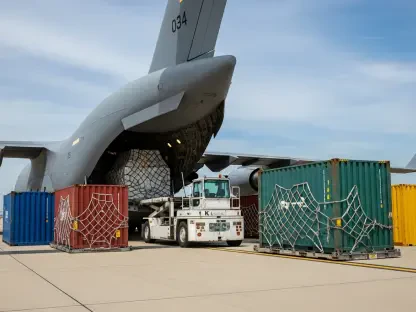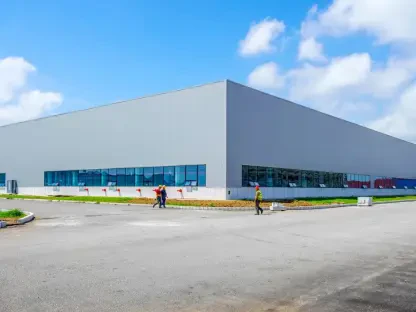The Defense Logistics Agency (DLA) Aviation is undergoing a transformative period, propelled by the implementation of a state-of-the-art Warehouse Management System (WMS). This significant modernization aims to streamline workflows, improve inventory management, and bolster support for the warfighters. The following sections detail the scope and impact of this groundbreaking initiative, from system features to operational improvements and the challenges encountered along the way. The new WMS, based on System Application and Products (SAP), signifies a much-needed upgrade from the outdated Distribution Standard System. This modern tool introduces capabilities such as enhanced visibility and traceability of inventory locations, movements, and deliveries. The transition is fundamentally aimed at achieving greater operational efficiency and ensuring financial accountability, aligning with the broader objectives of modernizing the agency’s logistics operations.
A Modern System for a Modern Era
The arrival of the new WMS brings DLA Aviation into a new era of technological advancement, marking a departure from the old Distribution Standard System. The system is built on System Application and Products (SAP), providing capabilities that far surpass those of its predecessor in terms of visibility and traceability of inventory. This visibility is crucial for numerous reasons. Enhanced tracking of inventory locations, movements, and deliveries ensures an effective response to the dynamic needs of the agency, resulting in improved operational efficiency. These improvements not only aid in day-to-day functionality but also add an extra layer of financial accountability, a priority for an organization entrusted with significant resources.
The implementation of the WMS highlights a strategic effort to embrace modern technology to meet the agency’s present and future needs. The enhanced traceability offered by the new system allows for better forecasting and planning, as inventory movements can be monitored minutely. This enhanced system ensures that no resource goes untracked, which is vital for both operational smoothness and stringent fiscal management. Adopting SAP technology places DLA Aviation at the forefront of logistics innovation, setting a benchmark in the military sector for how inventory systems should operate in today’s fast-paced environment.
Real-Time Data Access Transforms Operations
One of the system’s most impactful features is its real-time data access, which has already exhibited notable benefits at facilities such as San Diego. With the WMS in place, tracking inventory quantities and locations has become more accurate and streamlined. This has resulted in improved order accuracy and better utilization of warehouse space. The capability to reduce cycle times allows the facility to handle increasing demands with enhanced agility, ultimately improving service for their primary customers—the warfighters. The real-time data feature of the WMS facilitates immediate decision-making, ensuring that resources are allocated where they are needed most, without delays or second-guessing.
The benefits of real-time data extend beyond mere inventory tracking. They impact the entire workflow, from order processing to final delivery. The system ensures that information is consistently updated and accurate, which is vital for maintaining high standards in inventory management. This accuracy minimizes errors and reduces the time spent on correcting them, thereby freeing up manpower for more critical tasks. By enhancing the precision with which orders are processed and filled, the agency can significantly boost the efficiency of warehouse space utilization. These operational improvements promise not only to meet but to exceed the expectations of the end-users, primarily the warfighters who rely heavily on timely and accurate deliveries.
Familiarity with SAP Eases Transition
The relatively smooth transition to the new WMS can be largely attributed to its basis in SAP, similar to the well-known Enterprise Business System (EBS). This common framework has significantly reduced the learning curve for users, enabling quicker adaptation and full use of the system’s features. The migration to WMS benefited greatly from user familiarity with SAP products, which ensured a seamless navigation and operational experience. This pre-existing proficiency meant that staff could quickly leverage the enhanced capabilities of the new system, leading to a faster and more effective transition.
The commonality between the old and new systems in terms of navigation and basic functionalities has been a boon for users, who can now utilize the new WMS with relative ease. This ease of use is crucial in any technological upgrade, as it allows the organization to continue operating efficiently without prolonged downtime for training and adaptation. The enhanced capabilities of the WMS were thus quickly accessible, with staff able to begin reaping the benefits almost immediately. This smooth transition underscores the importance of building new systems on familiar platforms, ensuring that technological advancements do not come at the cost of operational efficiency.
Challenges and Solutions in Implementation
Transitioning to the new WMS wasn’t without its share of challenges. Early on, issues such as unauthorized breaches of protected stock, order duplication, and delays in work-in-progress emerged. These problems required intensive collaboration between DLA Aviation headquarters and individual sites. The nature of the issues necessitated a proactive approach, engaging logistics, IT, and operational staff in extensive teamwork. The complexity of the new system highlighted the importance of a collaborative effort to overcome the hurdles and ensure a smooth operational transition.
By addressing these issues head-on, the teams involved were able to gradually rectify initial problems, demonstrating the critical role of teamwork in successfully implementing complex systems. The challenges faced during the transition emphasized the need for robust coordination and communication among various departments. Tackling problems such as unauthorized stock breaches and order duplication required a multifaceted approach, engaging a range of skill sets from across the organization. These collaborative efforts proved instrumental in the gradual resolution of the encountered issues, underscoring the importance of cross-departmental teamwork in overcoming technological challenges.
The Role of Business Process Analysts
Business Process Analysts played a pivotal role in addressing the initial challenges of transitioning to the new WMS. These professionals worked closely with technical teams to identify and rectify problems, such as the WMS mapping error that led to transaction duplications. Their hands-on involvement was crucial in ensuring that the system performed optimally. Business Process Analysts’ expertise was instrumental in troubleshooting and resolving issues, demonstrating the significance of having specialized analysts during such significant transitions.
Their concerted efforts to pinpoint and solve issues ensured that the system could function as designed, highlighting the importance of precise and informed problem-solving. The role of these analysts cannot be overstated; their ability to bridge the gap between technical teams and operational staff was critical in facilitating a smoother transition. This collaborative approach underscored the necessity of having dedicated personnel focused on process optimization, particularly during the early stages of adopting a complex new system.
Success Stories and Operational Improvements
One of the most significant success stories from the WMS implementation relates to addressing delays caused by the initial design of consolidated picklists. Under the leadership of DLA Aviation Deputy Commander Charlie Lilli, the system reverted to a more straightforward practice of “one Material Release Order to one requisition.” This change significantly reduced backlogs and improved delivery times, underscoring the critical role of responsive leadership in navigating complex transitions. The resolution of this issue highlights how targeted adjustments can lead to substantial improvements in operational efficiency.
This successful adaptation is a testament to the agency’s commitment to continuous improvement and operational effectiveness. The decision to streamline the picklist process reflects a broader strategy of simplifying workflows to enhance efficiency. By reverting to a more straightforward approach, the organization was able to clear backlogs and ensure timely deliveries, meeting the needs of their primary customers—the warfighters. This success story illustrates the agency’s capacity to adapt and optimize its operations, establishing a model for future technological transitions.
Preparing for Future Implementations
As DLA Aviation looks ahead to implementing the WMS at Air Force sites, the lessons learned from the Navy transitions will be invaluable. Key takeaways include the critical need for frequent, transparent communication and early stakeholder involvement. Engaging all relevant parties from the outset ensures that potential issues are identified and addressed early, facilitating smoother transitions. By incorporating these lessons, future implementations are anticipated to proceed more efficiently, setting a precedent for continuous improvement and operational excellence.
Preparing for future implementations also involves a commitment to ongoing learning and adaptation. The experiences from the Navy sites provide a roadmap for approaching similar transitions in other branches of the military. The focus on transparent communication and proactive stakeholder engagement underpins a strategy of inclusivity and foresight. This approach ensures that all relevant voices are heard, and potential challenges are addressed collaboratively, paving the way for a successful roll-out of the new system across different sites.
Anticipated Enhancements and Future Vision
One of the system’s most impactful features is its real-time data access, which has already proven beneficial in places like San Diego. With the WMS implemented, inventory tracking has become more precise and efficient. This leads to better order accuracy and optimal warehouse space use. By reducing cycle times, the facility can handle growing demands with increased agility, thus enhancing service for their primary customers—the warfighters. The WMS’s real-time data feature allows immediate decision-making, ensuring resources are allocated promptly without delays or guesswork.
The advantages of real-time data go beyond mere inventory tracking. They affect the entire workflow, from order processing to delivery. The system keeps information consistently updated and accurate, crucial for high standards in inventory management. This level of accuracy minimizes errors and reduces the need for corrections, freeing up manpower for critical tasks. By improving order processing and fulfillment precision, the agency can vastly enhance warehouse space efficiency. These operational gains promise not only to meet but also exceed the expectations of the end-users, particularly the warfighters who depend on timely, accurate deliveries.









